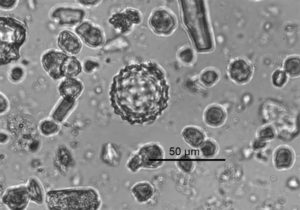
PROCEEDINGS OF THE NATIONAL ACADEMY OF SCIENCES—Analyzing charcoal and phytolith records of soil cores from nonflooded, nonriverine forests in northeastern Peru, researchers found* that the forests were not significantly altered by anthropogenic activity in pre-Columbian history, and material remains of ancient cultures, such as ceramics and stone tools, were also absent from soil samples; the findings suggest that over the last 5,000 years indigenous societies in northeastern Peru helped maintain regional forest integrity and biodiversity, according to the authors.
___________________________

Ancient plant microfossils called phytoliths from northeastern Peru. Dolores R. Piperno.
___________________________
Article Source: PNAS news release
*”A 5,000-year vegetation and fire history for tierra firme forests in the Medio Putumayo-Algodón watersheds, northeastern Peru,” by Dolores R. Piperno et al.
___________________________
Advertisement





